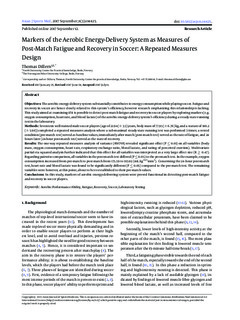| dc.contributor.author | Dillern, Thomas | |
| dc.date.accessioned | 2018-03-02T13:47:57Z | |
| dc.date.available | 2018-03-02T13:47:57Z | |
| dc.date.created | 2018-01-26T09:44:04Z | |
| dc.date.issued | 2017 | |
| dc.identifier.citation | Dillern, T. (2017). Markers of the aerobic energy-delivery system as measures of post-match fatigue and recovery in Soccer: A repeated measures design. Asian Journal of Sports Medicine, 8(3): e14425. doi: | nb_NO |
| dc.identifier.issn | 2008-7209 | |
| dc.identifier.uri | http://hdl.handle.net/11250/2488373 | |
| dc.description.abstract | Objectives: The aerobic energy-delivery system substantially contributes to energy consumption while playing soccer. Fatigue and recovery in soccer are hence closely related to this system’s efficiency, however research emphasizing this relationship is lacking. This study aimed at examining if it is possible to detect post-match fatigue and recovery in soccer players by exploring markers (e.g. oxygen consumption, heart rate, and blood lactate) of the aerobic energy-delivery system’s efficiency during a steady-state running test in the laboratory.
Methods: Seventeen well-trained male soccer players (age of 21.94 (± 3.5) years, body mass of 77.95 (± 6.76) kg, and a stature of 180.2 (± 5.98)) completed a repeated measures analysis where a sub-maximal steady-state running test was performed 3 times; a rested condition (pre-match test) served as baseline values, immediately after match (post-match test) served as the rate of fatigue, and 24 hours later (24-hour post-match test) served as the state of recovery.
Results: The one-way repeated measures analysis of variance (ANOVA) revealed significant effect (P ≤ 0.01) on all variables (body mass, oxygen consumption, heart rate, respiratory exchange ratio, blood lactate, and rating of perceived exertion). Multivariate partial eta squared analysis further indicated that this effect for all variables was interpreted as a very large effect size (R ≥ 0.47). Regarding pairwise comparison, all variables in the post-match test differed (P ≤ 0.05) to the pre-match test. In the example, oxygen consumption increased from pre-match to post-match from 175.59 to 183.02 (mL.kg-0.25·min-1). Concerning the 24-hour post-match test, heart rate and blood lactate was found to be significantly different (P ≤ 0.05) compared to the pre-match test. The remaining variables were however, at this point, about to be re-established to their pre-match values.
Conclusions: In this study, markers of aerobic energy-delivering system were proved functional in detecting post-match fatigue and recovery in soccer players. | nb_NO |
| dc.language.iso | eng | nb_NO |
| dc.publisher | Tehran University of Medical Sciences Publications | nb_NO |
| dc.rights | Navngivelse-Ikkekommersiell 4.0 Internasjonal | * |
| dc.rights.uri | http://creativecommons.org/licenses/by-nc/4.0/deed.no | * |
| dc.title | Markers of the Aerobic Energy-Delivery System as Measures of Post-Match Fatigue and Recovery in Soccer : A Repeated Measures Design | nb_NO |
| dc.type | Journal article | nb_NO |
| dc.type | Peer reviewed | nb_NO |
| dc.description.version | publishedVersion | nb_NO |
| dc.rights.holder | © 2017, Asian Journal of Sports Medicine | nb_NO |
| dc.subject.nsi | VDP::Samfunnsvitenskap: 200::Samfunnsvitenskapelige idrettsfag: 330 | nb_NO |
| dc.source.pagenumber | 7 | nb_NO |
| dc.source.volume | 8 | nb_NO |
| dc.source.journal | Asian Journal of Sports Medicine | nb_NO |
| dc.source.issue | 3 | nb_NO |
| dc.identifier.doi | 10.5812/asjsm.14425 | |
| dc.identifier.cristin | 1552395 | |

